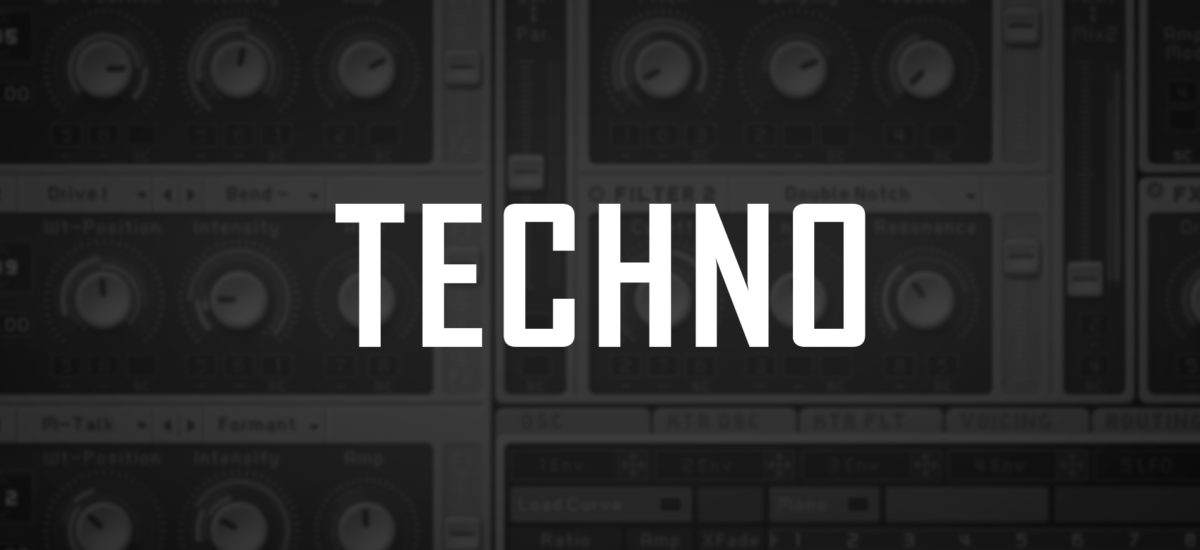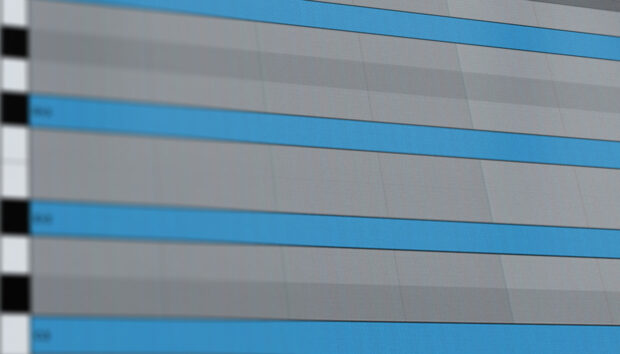
The story of techno sound-design is an unlikely one. A case study in experimentation and reappropriation, in which an unruly selection of noise, and drum machines came to soundtrack a futurist punk revolution. By the mid 80s, the dominance of expensive analog studio equipment had been challenged, as affordable digital synthesisers began to flood the domestic market, creeping into bedroom studios. By the mid 90s sound design was suddenly, and radically democratised, and by the 2000s a new age in bass potential was born. Here are some hallmark techno bass picks from NI’s MASSIVE library; snapshots from a futuristic low-end revolution which continues to evolve.
Back to basics
Embracing, rather than eschewing the ‘unreal’, techno has continued to clone, destroy and counterpoint analog’s warmth, and anomaly with digital imagination – the imperfect with the genetically modified, the ‘preset’ with the unpredictable. Many of techno’s most distinctive ‘bass’ sounds are not contrived emulations at all – but rather creatively manipulated presets and audio (organs, sound fx) from a vast sea of synthesis.
Berlin’s original dub-techno luminaries ostensibly created the template for a new decade of European techno minimalism. Their approach to sound design was marked by liminality and empty space, anchored by simple, cavernous sine-wave bass sensibilities.
Across the waters in Michigan, the Motor City heros rode a similar trajectory, sailing on the sinewaves of a new generation of Frequency Modulation (FM) synthesisers, all in service of Motown’s new underground funk resistance. FM synthesis was deceptively deep, with its rich bell-like harmonics gracing numerous early Detroit imprints.
Uniting these parallel visions was an elegant, minimalistic approach to low-end sound-design – and no shortage of cybernetic melancholy.
B-Low, Classics, Basement and decisively nod to Berlin’s dub-drenched techno sound, with macro controls allowing for further expansion of a reductionist palette.
Lately, FM Plastique, Attacker and Oldschool Bass may, meanwhile, be the only ‘DX style’ bass patches you’ll ever need. Both calling to mind the spirited cosmic booty workouts of Detroit’s Floorplan and Eddie “Flashin” Fawlkes.
Glassbreaker is rich digital overtones, whilst House Organ Bass is a picture-perfect clone of a sound which spawned a thousand minimal classics.
This is Acid
The so-called ‘acid house revival’ has been in full swing for the last 20 years or so, mere moments after its’ first ecstatic flush.
From the gurgling spasms of Phutures ‘Acid Trax’ to the overdriven scream of Winx’s ‘Higher State of Consciousness’, the stolid thump and resonant bite of TB-style acid remains a techno staple.
The strength of the original analogue acid machines (the TB-303, SH-101 and MC-202) were not so much their tone (simple, monophonic square and sawtooth waveforms) as much as their idiosyncratic sequencing and immediately tweakable set of controls.
MASSIVE’s go-to acid bass patches include the aptly named Acid Bass, the barking wheeze of 3 Silver Lines and the demented and self-sequencing Timberland Acid House.
Teebee Machine and A Square in Space offer more ‘bread and butter’ emulations, sans sequencer, of the classic acid machine.
Intificial Artelligence injects similar vision with fully-loaded macro controls, transforming a familiar palate into a bristling, bouncing, industrial rave-bot.
The hardcore continuum
It’s too easy to omit an entire movement from techno’s officially romantic history – particularly if that movement lacks the tortured lustre of Berlin or Detroit. Yet techno, as we know it, owes a debt of gratitude to the Dionysian, suburban nihilism of hardcore techno and gabba.
At the bleeding heart of this mutant sound is, of course, the ‘hoover’ style bass.
99 Reese and Legato Killer all pay homage to an unlikely factory patch which first appeared in the late 80s. Apocryphally, this sound became known as the ‘hoover sound’, achieving notoriety on countless hard-style records, and later in the post-techno incarnations of dubstep and EDM
All MASSIVE patches embrace playful, dynamic takes on an aggressive original, with assignable LFO controls generating writhing filter movement.
Hisstamin is a genetic redux of hardcore detuned bass coarseness – calling to mind the moment in which producer Darude achieved bonafide crossover infamy.
Gracing previous techno works from luminaries like Joey Beltram to Kevin Saunderson (producing as Reese), this brooding, sub-bass ‘wobble’ has experienced multitude reincarnations, in recent years providing the bedrock low end of UK dubstep’s dysphoria (fans of Burial take note!)
Nodding to this enduring legacy, Native Instruments recent Stadium Flex even includes a skulking lurker of a patch entitled “Save Reese”.
Everything old is new again
From the brazen punk of Modeselektor to the rave-sirens of warehouse heros Dense & Pika, the last decade has seen a renaissance in the throbbing gratuity of rave exuberance.
Patches 2am, Absolute and the mighty Coneblower kick like wounded mules – all the more gratifying when threatening to rupture a towering Funktion One sound-system (yet equally gratifying via a set of laptop earbuds).
These sounds ache and bustle in imagined space – snarking through paper bass bins a club from futures past. Marcos afford perfectly placed tonal control for a genre which is at once old yet suddenly new again.
Nocturnal State Expansion updates MASSIVE’s classic template with brooding, big room girth. Fans of contemporary heroes like DVS1 and Ben Klock take note, 40 cavernous bass patches like Intruder, Horses, Colossal and, Brute deliver swollen, ruptured rave devastation, with additional audio material from examples taken from TRX Machinemusic’s Analogue Ghettotech Tools collection.
*For any interested in further reading on the history of synth presets, Stefan Goldmann’s brilliant work is infinitely engaging and imbued with understated humor, and this series of videos on presets makes for compelling viewing. Diving deeper, Simon Reynold’s work on the electronic music’s Hardcore Continuum makes for compelling, vital reading.















